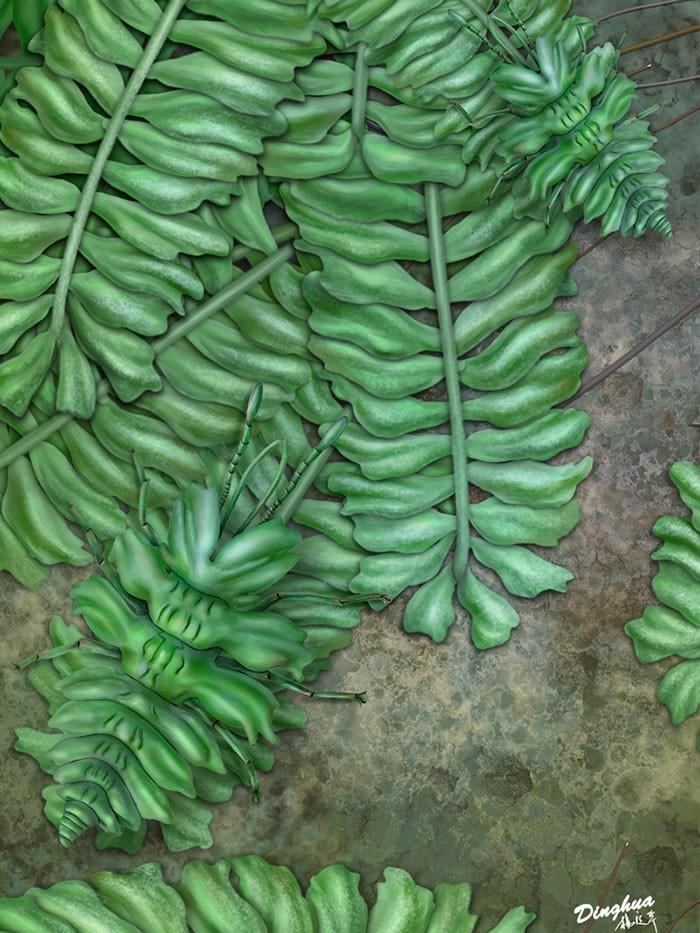
Ecological restoration map of Huang's mossy grasshopper
Burmese amber in the Yellow moss grasshopper
According to the Nanjing Institute of Geology and Paleontology of the Chinese Academy of Sciences: Recently, Researcher Wang Bo and Associate Researcher Shi Gongle of the "Research Team on the Origin and Early Evolution of Modern Terrestrial Ecosystems" of the Nanjing Institute of Geology and Paleontology of the Chinese Academy of Sciences cooperated with the research team of Professor Liu Xingyue of China Agricultural University to discover a peculiar class of insect larvae mimetic bryophytes from the amber of Burmese amber in the Cretaceous Period 100 million years ago.uux.cn The result is the first occurrence of mimetic moss behavior in fossil insects, providing new evidence for reconstructing the ecological relationship between ancient insects and plants. The results were published online in the journal Current Biology, a cell publishing group.
Over the course of its long geological history, insects have evolved different camouflage techniques. Among them, insect imitation of plants is the most common one. With this type of mimesis, insects can hide in plants to avoid being discovered by predators, while also making it difficult for prey to detect themselves, which plays a role in killing two birds with one stone. In modern nature, insects are mostly mimetic ferns and seed plants with leaves, branches and flowers, and a very small number of insects can mimic bryophytes. Bryophytes were one of the first terrestrial plants to spread around the world, providing food for insects and shelter. However, in geological history, the ecological relationship between insects and bryophytes has rarely been recorded, and the behavior of fossil insects simulating mosses has not been seen.
The insects reported this time are larvae of the family Phylloscopidae, commonly known as aphid lions. The species was named Huang's moss grasshopper, and the species name was named after the donor of the type specimen (Mr. Huang Jiren of Taiwan). Unlike all known larvae of the family Phylloscopidae, the mossy grasshopper develops a total of 8 pairs of flattened leaf-like structures on the thorax and the anterior 5 segments of the abdomen, which are very similar in appearance to the moss plant body. In addition , the species has a relatively degenerated head and is hidden under the lateral lobes of the forehorax , with a pair of extremely long and enlarged antennae at the tip and a pair of elongated, inwardly curved jaws , which are used to detect and prey, respectively.
The study also identified several groups of mosses that the species may mimic. Among them, the moss grasshopper shows great morphological similarity with several types of leaf mosses, including individual size, leaf shape and arrangement, leaf folds and lines. Therefore, this study inferred that moss grasshoppers are likely to mimic leaf mosses, using this type of camouflage to avoid predators, but also confuse prey and improve the success rate of predation.
This study was supported by the Chinese Academy of Sciences and the National Natural Science Foundation of China. Yang Dinghua, a cartographer at the Nanjing Institute of Paleontology, drew a restoration map.
相关论文:Liu Xingyue*, Shi Gongle, Xia Fangyuan, Lu Xiumei, Wang Bo*, Engel M.S.* (2018) Liverwort mimesis in a Cretaceous lacewing larva. Current Biology
Science popularization 100% helps science popularization in China, so that scientific knowledge becomes popular on the Internet and in life. Warm tips: The above is 100% popular science online reading browsing content, reprint sharing only for knowledge dissemination and learning publicity, the content of this article only represents the original author's views, if there are comments and suggestions, please leave a private message, we will deal with it in a timely manner. Welcome to the attention, thank you.